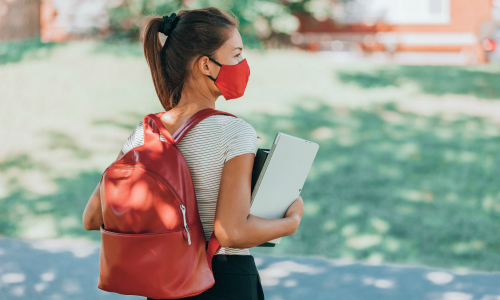Campus Safety Survey: COVID-19 Is Driving Big Access Control Changes
The pandemic is impacting everything from policies to technology uses, according to the 2020 Campus Safety Access Control, Lock and Lockdown Survey.

As with everything else in our world right now, COVID-19 is significantly impacting many aspects of campus access control, according to a survey of nearly 300 school, university and healthcare security professionals conducted by SSI sister publication Campus Safety.
When reviewing the findings of this year’s Campus Safety Access Control, Lock and Lockdown Survey, it’s important to remember that it was conducted in June when the country was reopening after the shutdown and many Americans mistakenly believed life could go on as it did before the pandemic. In July, however, the number of COVID-19 infections, hospitalizations and deaths in the United States skyrocketed, and many states that fully reopened dialed back their reopening efforts or made major adjustments.
VIEW THE CHARTS AND FULL REPORT
The same can be said for schools and universities. By the end of July and beginning of August, most of America’s largest K-12 districts announced they would start the 2020-2021 academic year with virtual instruction only. By mid-August, only 49% of colleges still indicated they planned on an in-person fall semester, reports the Chronicle of Higher Education. In late June, that percentage was nearly 65%. By late August, many college campuses that started out the semester offering in-person classes, including UNC Chapel Hill and Notre Dame, switched to distance learning due to a spike in positive COVID-19 infections in their student and employee populations.
The same can be said for schools and universities. By the end of July and beginning of August, most of America’s largest K-12 districts announced they would start the 2020-2021 academic year with virtual instruction only. By mid-August, only 49% of colleges still indicated they planned on an in-person fall semester, reports the Chronicle of Higher Education.
In late June, that percentage was nearly 65%. By late August, many college campuses that started out the semester offering in-person classes, including UNC Chapel Hill and Notre Dame, switched to distance learning due to a spike in positive COVID-19 infections in their student and employee populations.
With this in mind, it’s safe to assume that the number of K-12 and higher-ed respondents who indicated in June that their organizations would continue distance learning as the sole option for classes has increased from the 23% recorded by this year’s survey. Additionally, now that new studies indicate children may be major drivers of the pandemic, schools and universities now are probably less confident that their organizations will be able to protect their community members from being infected by the coronavirus.
As far as the confidence level of hospital respondents is concerned, it’s probably reasonable to assume that the level hasn’t decreased as much as it has for K-12 and higher-ed campuses. This is because hospitals have been on the frontline, fighting the pandemic, so they probably have always had a more realistic understanding of the coronavirus threat.
Policies and Procedures Affected Most by COVID-19
This year’s Campus Safety Access Control, Lock and Lockdown survey found that policies and procedures have been affected most, with 65% of U.S. schools and 60% of colleges saying they are limiting the number of visitors to their campuses, and nearly one in three are not allowing visitors at all due to the pandemic. Nearly two-thirds of K-12 respondents (61%) and 72% of higher-ed respondents say class sizes are being reduced, and 39% of higher education survey participants say they are reducing dorm room occupancy.
Seven in 10 schools and colleges now require students, faculty, staff and visitors to wear masks. Broken down by type of campus, more institutions of higher education have adopted this requirement, with 85% requiring face coverings compared to 64% of K-12 campuses. For those individuals who might not have their own facemasks with them, 64% of K-12 and 78% of higher-ed survey participants say their organizations would provide masks.
Temperature checking of faculty, staff, students and visitors is another popular policy adopted by nearly two-thirds of school respondents and a little over a third of colleges and universities. One in three schools and 26% of universities have revised their lockdown policies and procedures. A quarter of K-12 campuses and 21% of institutions of higher education have revised their emergency notification policies and procedures.
Some Considering Adoption of New, Additional Technology
There are many security technologies that can help slow the spread of COVID-19 and reduce the need for individuals to touch a doorknob or other high-touch areas. Additionally, video surveillance and intercoms can help campus staff members track compliance with face covering requirements.
Before the pandemic, a significant number of hospital, higher education and school survey respondents had already adopted many of these technologies, including intercoms (50%), proximity cards (49%), visitor management software (30%), locks with anti-microbial coatings/surfaces (28%) and smart cards (26%). The pandemic is an opportunity for campuses with these systems to expand their uses and increase the return on their technology investments.
Nine percent of respondents say they’ve newly adopted or will soon be adding visitor management software, while 7% say they’ve just bought or will soon buy hands-free door pulls. Six percent say they have recently adopted or will soon add touchless door openings, automatic doors, mobile phone credentials, facial recognition and intercoms, while 5% have just obtained or will soon get proximity card, smart card or biometric access control. About half of these systems have been or are being adopted in response to the pandemic.
Visitor management software is being considered by 19% of respondents, while 17% are considering the adoption of mobile phone credentials and hands-free door pulls. Fifteen percent are considering smart card access control, while 14% are considering touchless door openings and facial recognition via video surveillance cameras.
More than one in four institutions of higher education (28%) say they will use technology for contact tracing, while 17% of colleges and 14% of K-12 schools say they will use technology to monitor social distancing.
How Will Face Mask Requirements Be Enforced?
Numerous studies have proven that the spread of COVID-19 can be slowed when everyone wears face coverings and engages in physical distancing. However, one only needs to go online to view countless videos of arguments over someone not wearing a mask or staying six feet apart from others to understand that these confrontations have the potential to come on campus.
Enforcement of COVID-19 guidelines, however, is a real challenge, but who will enforce the rules?
Our survey found that administrators are most often tasked with enforcement (88% for K-12, 61% for higher ed and 52% for healthcare), while staff members often have this responsibility (68% for schools, 61% for colleges and 78% for hospitals). Overall, 9% said no one would enforce their organization’s mask and social distancing requirements.
The survey also found that campus police, public safety and/or security frequently are tasked with enforcement. It should be noted, however, that at this summer’s Campus Safety Online Summit, many of the campus protection practitioners who participated in the event warned against public safety officers engaging in enforcement of mask requirements. Instead, the approach they are adopting is one of encouragement and public awareness.
Visitor Management, Lockdown Hardware Issues Remain
Although COVID-19 is currently dominating practically every area of our lives, the CS 2020 Access Control, Lock and Lockdown Survey covered some other topics that apply now and will continue to apply after the pandemic.
Visitor identification is one such topic. It turns out that 46% of higher-ed respondents and 43% of healthcare respondents say their organizations don’t check visitor identification before a guest is allowed entry. K-12 school districts, however, are much more vigilant when it comes to visitor management — only 14% don’t check guest IDs.
For those campuses that do verify visitor identity, police/security officers or staff are most likely the ones assigned this responsibility (44%). Video intercoms are particularly popular with schools and districts (49%), and about one in three (32%) use audio intercoms for visitor ID verification.
Another topic that is always of interest to schools, universities and hospitals is lockdown. Unfortunately, a disturbingly low portion of survey respondents (53% of schools, 42% of colleges and 38% of healthcare facilities) say their lockdown hardware is fast enough to protect against threats. About one in five overall aren’t sure.
Although campuses are currently focused on appropriately addressing the issues brought up by the coronavirus, visitor management and lockdown hardware issues will most likely continue long after the current pandemic passes.
This article first appeared on SSI sister publication Campus Safety.
If you enjoyed this article and want to receive more valuable industry content like this, click here to sign up for our FREE digital newsletters!

Security Is Our Business, Too
For professionals who recommend, buy and install all types of electronic security equipment, a free subscription to Commercial Integrator + Security Sales & Integration is like having a consultant on call. You’ll find an ideal balance of technology and business coverage, with installation tips and techniques for products and updates on how to add to your bottom line.
A FREE subscription to the top resource for security and integration industry will prove to be invaluable.







